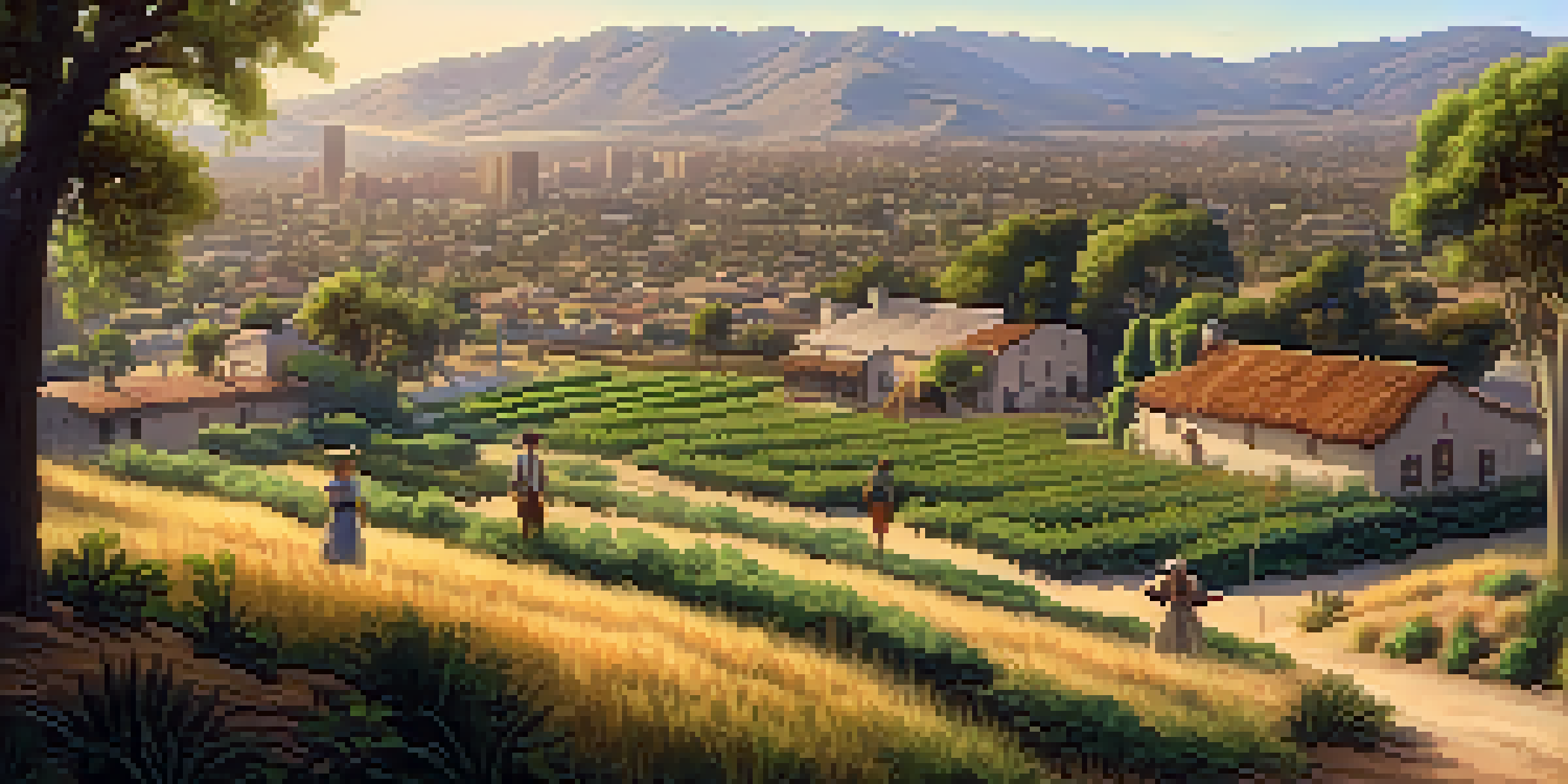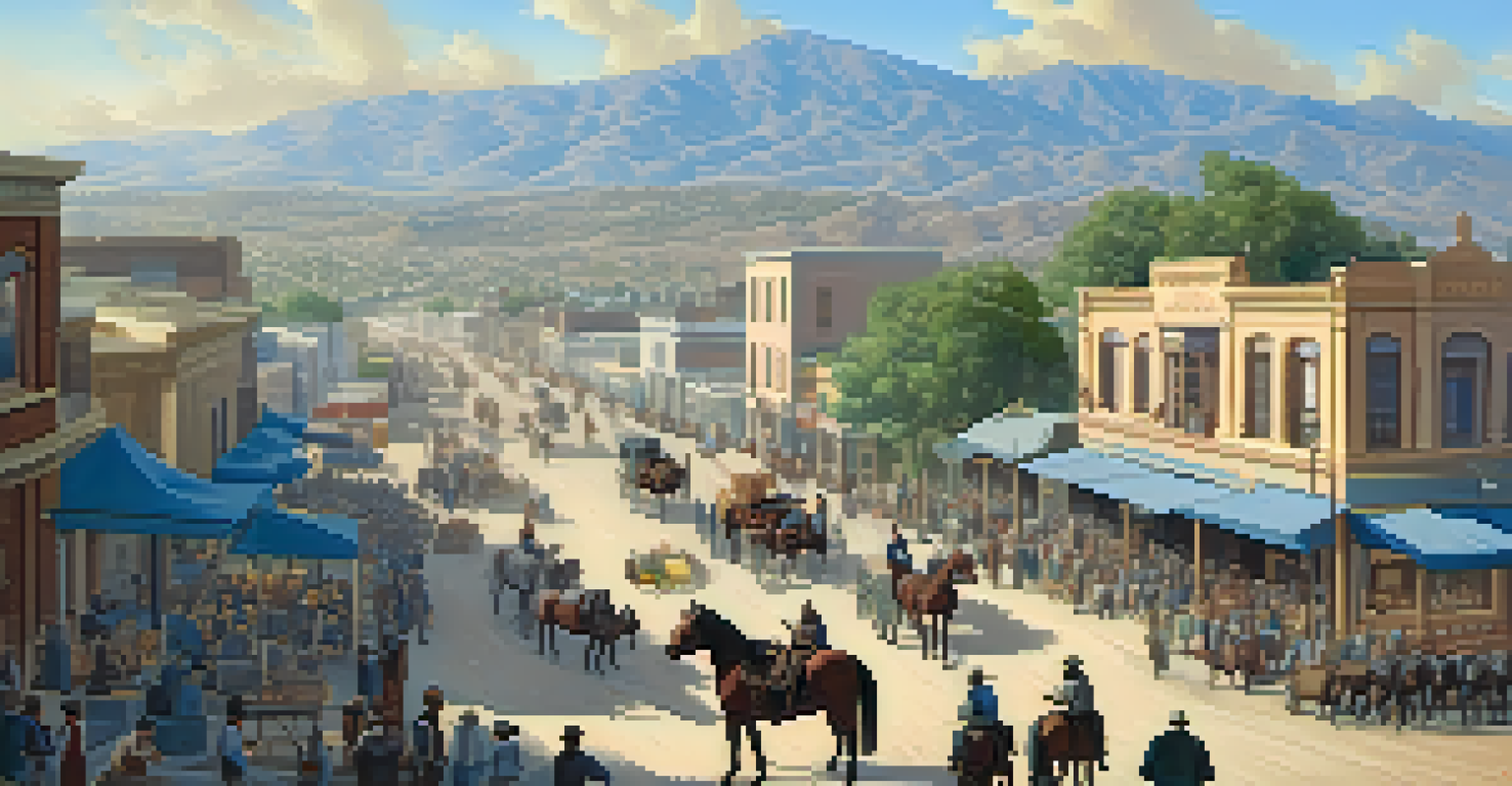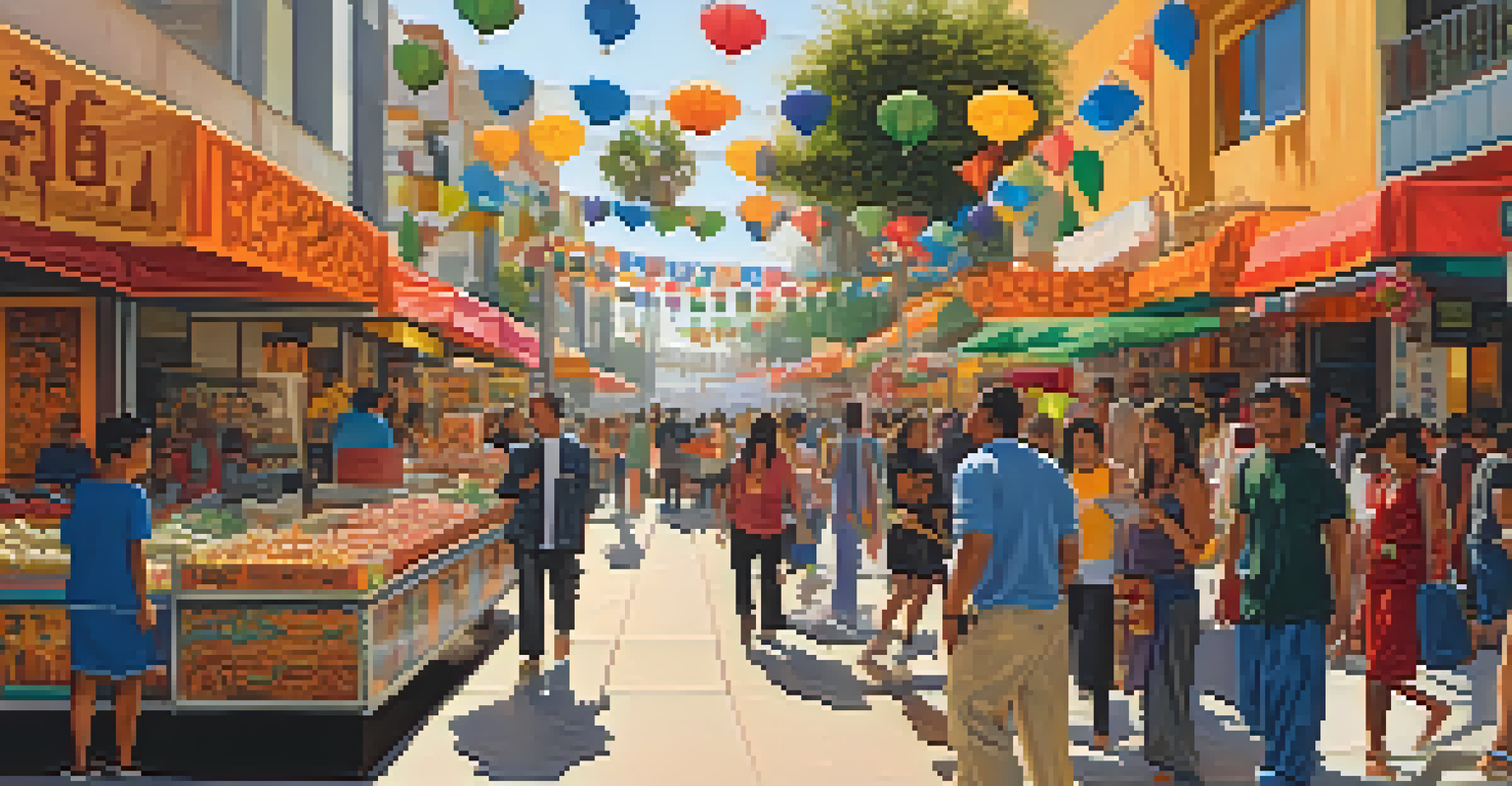The Origins of Los Angeles: From Pueblo to Metropolis

The Founding of El Pueblo de Los Ángeles in 1781
Los Angeles began as a small settlement known as El Pueblo de Los Ángeles, founded on September 4, 1781, by Spanish settlers. This quaint pueblo, which translates to 'The Town of Angels,' was established to secure Spanish claims to the area and support the nearby missions. Its initial population consisted of 44 settlers, mostly of mixed heritage, reflecting the multicultural nature of early California.
Los Angeles is a city of dreams, where aspirations are born and creativity knows no bounds.
The choice of location was strategic, nestled between the mountains and the ocean, providing ample resources and trade routes. The area was lush with water from the Los Angeles River, making it an ideal place for agriculture and sustenance. Over the years, this small settlement grew, laying the foundation for what would become a bustling metropolis.
As the pueblo developed, it became a center for commerce and culture, attracting people from various backgrounds. The influence of Indigenous cultures, Spanish traditions, and later Mexican governance created a unique tapestry that would shape the identity of Los Angeles for generations to come.
Mexican Rule and Its Impact on Growth
In 1821, Mexico gained independence from Spain, and Los Angeles became part of Mexican territory. This transition brought significant changes, including land reforms and the establishment of ranchos, which transformed the economic landscape. These vast ranchos allowed for cattle ranching and agriculture to flourish, contributing to the area's growth.

The Mexican era also saw an increase in population as immigrants from Mexico and other regions settled in Los Angeles. This influx enriched the cultural heritage of the area, introducing new customs, foods, and traditions. The blending of these influences made the city a vibrant hub of diverse communities.
Los Angeles' Diverse Origins
Founded in 1781, Los Angeles emerged from a multicultural settlement, reflecting a blend of Indigenous, Spanish, and Mexican influences.
However, the Mexican-American War in the mid-19th century led to significant shifts once again. In 1848, California was ceded to the United States, marking the start of a new chapter for Los Angeles and setting the stage for its transformation into a major American city.
The Gold Rush and Economic Expansion
The discovery of gold in California in 1848 had a profound effect on Los Angeles, driving an influx of people seeking fortune. This Gold Rush spurred economic growth, as thousands flocked to the state, many passing through or settling in Los Angeles. The city became a critical supply hub for miners heading to the goldfields, boosting local businesses and infrastructure.
Diversity is the one true thing we all have in common. Celebrate it every day.
As the population surged, so did the need for services, leading to the establishment of schools, churches, and other civic institutions. This growth laid the groundwork for a more structured society and the formal governance of Los Angeles. New roads and railroads were constructed to accommodate the increasing traffic, cementing the city's role as a vital link in the region.
However, this rapid growth wasn't without challenges. The city faced issues related to housing, sanitation, and law enforcement as it struggled to keep pace with the burgeoning population. Despite these hurdles, the seeds of a metropolis were being sown, setting the stage for future development.
Incorporation and the Rise of Los Angeles
Los Angeles officially became a city in 1850, shortly after California was admitted as a state. This incorporation marked a pivotal moment in its history, allowing for more organized governance and the establishment of a city charter. With formal recognition came an increased sense of identity and purpose for its residents, who were determined to shape their future.
The 1850s and 1860s saw further expansion, with the development of infrastructure like roads, railways, and telegraph lines, linking Los Angeles to other parts of California and beyond. This connectivity attracted more settlers and businesses, propelling the city's growth as a commercial center. The economy diversified, leading to advancements in agriculture, manufacturing, and trade.
Growth Fueled by the Gold Rush
The California Gold Rush in 1848 significantly boosted Los Angeles' economy and population, establishing it as a vital supply hub.
Despite facing natural disasters like floods and droughts, the resilience of the community shone through. The spirit of innovation and determination became a hallmark of Los Angeles, and by the late 19th century, the city was well on its way to becoming a vibrant metropolis.
The Advent of the Film Industry
The turn of the 20th century heralded the arrival of the film industry, which would forever change the landscape of Los Angeles. The area's sunny weather, diverse settings, and affordable land attracted filmmakers looking for the perfect backdrop for their stories. By the 1910s, Hollywood emerged as the epicenter of the burgeoning film industry, drawing talent from across the nation.
This cultural shift not only transformed the economy but also reshaped the identity of Los Angeles. The glamour and allure of Hollywood attracted aspiring actors, directors, and writers, making the city synonymous with the entertainment industry. The film boom created jobs, fueled tourism, and established Los Angeles as a global cultural capital.
As films became a dominant form of entertainment, the city began to cultivate a unique lifestyle and culture that celebrated creativity and innovation. The film industry’s influence extended beyond cinema, impacting fashion, music, and even architecture, solidifying Los Angeles's status as a trendsetter.
The Challenges of Urbanization
As Los Angeles grew, it also faced the challenges of urbanization, including overcrowding, pollution, and social inequality. The rapid influx of people from various backgrounds led to tensions and disparities in wealth and access to resources. Neighborhoods developed in clusters, some thriving while others struggled with poverty and lack of services.
Public transportation systems struggled to keep up with the growing population, leading to traffic congestion that persists to this day. The city grappled with environmental concerns as industrialization and urban sprawl took their toll on natural resources. Efforts to address these issues sparked community activism and awareness in the mid-20th century.
Cultural Melting Pot Today
Modern Los Angeles is celebrated for its rich cultural diversity, showcasing a vibrant mix of ethnicities and traditions that shape its identity.
This period of challenge prompted a wave of reforms and initiatives aimed at improving living conditions. Residents began to advocate for better public services, equitable housing, and environmental protection, paving the way for a more sustainable future.
Cultural Diversity and Global Influence
Today, Los Angeles is celebrated for its cultural diversity, a melting pot of ethnicities, languages, and traditions. This rich tapestry of cultures is reflected in the city's neighborhoods, festivals, and culinary scene, making it a vibrant place to live and visit. Areas like Chinatown, Little Tokyo, and Olvera Street showcase the city's multicultural heritage.
The global influence of Los Angeles extends beyond entertainment; it has become a leader in fashion, technology, and environmental sustainability. As the city continues to evolve, it remains a hub for innovation and creativity, attracting talent from around the world. This international appeal enhances its reputation as a trendsetter in various fields.

Despite its challenges, the spirit of Los Angeles endures, characterized by resilience and a commitment to community. As the city looks to the future, it continues to honor its rich history while embracing the possibilities of a diverse and interconnected world.